Analyzing the Role of Smartphones in Contemporary Journalism
VerifiedAdded on 2023/03/29
|6
|1000
|267
Essay
AI Summary
This essay critically examines the assertion that "Everyone with a Smartphone is a journalist," arguing that while smartphones provide accessible platforms for content creation and dissemination, they do not automatically equate to journalistic competence. The essay highlights the critical skills required for journalism, such as research, fact-checking, and ethical reporting, which go beyond simply owning a smartphone. It discusses the potential for the spread of misinformation and fake news through social media platforms, emphasizing the importance of journalistic training and responsibility in ensuring accurate and reliable information. The essay further explores the impact of digital and mobile journalism on the rise of fake news and underscores the essential qualities of a journalist, including honesty, storytelling ability, and open-mindedness, concluding that while smartphones are valuable tools, they cannot replace the skills and knowledge necessary for responsible journalism.
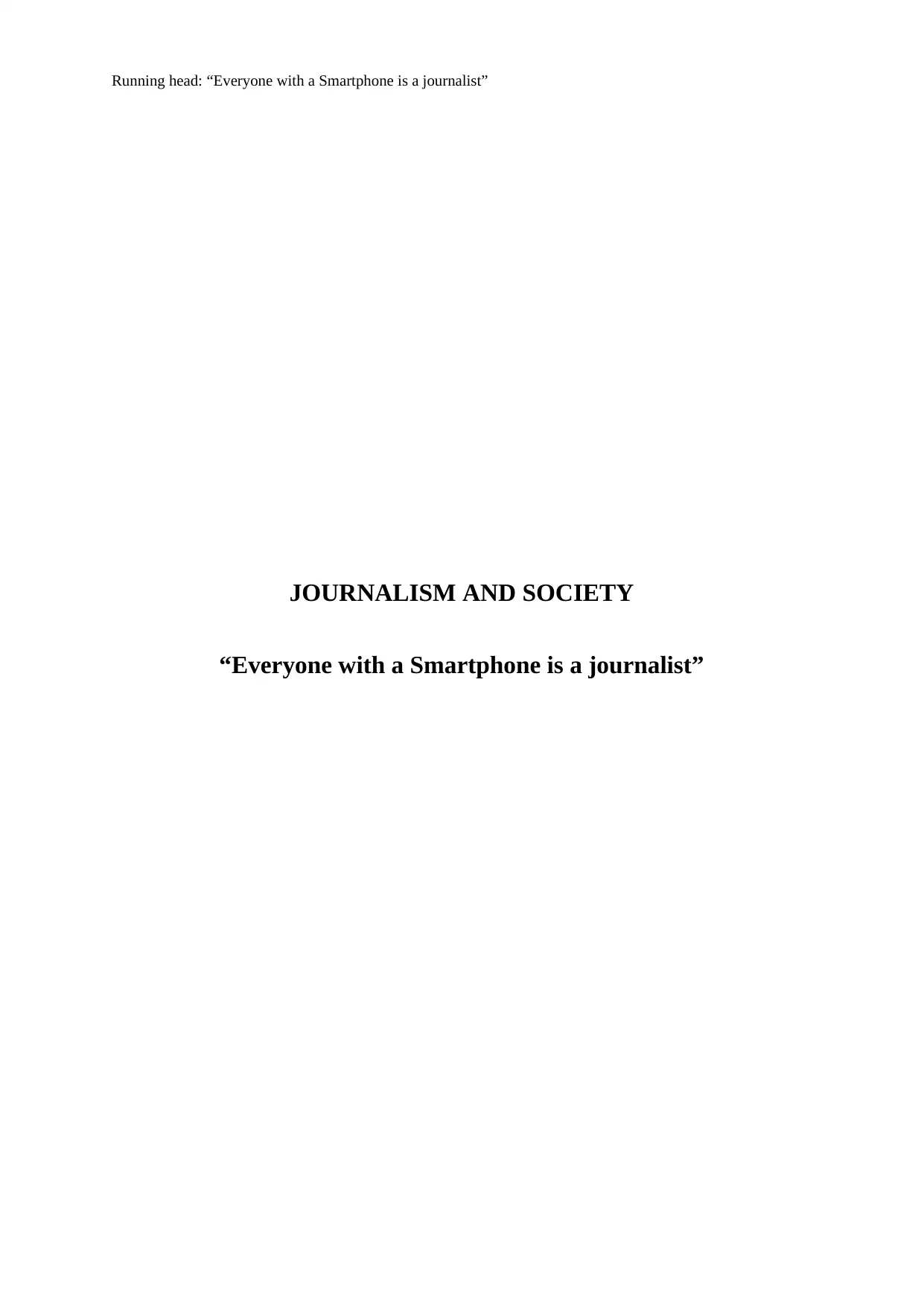
Running head: “Everyone with a Smartphone is a journalist”
JOURNALISM AND SOCIETY
“Everyone with a Smartphone is a journalist”
JOURNALISM AND SOCIETY
“Everyone with a Smartphone is a journalist”
Paraphrase This Document
Need a fresh take? Get an instant paraphrase of this document with our AI Paraphraser
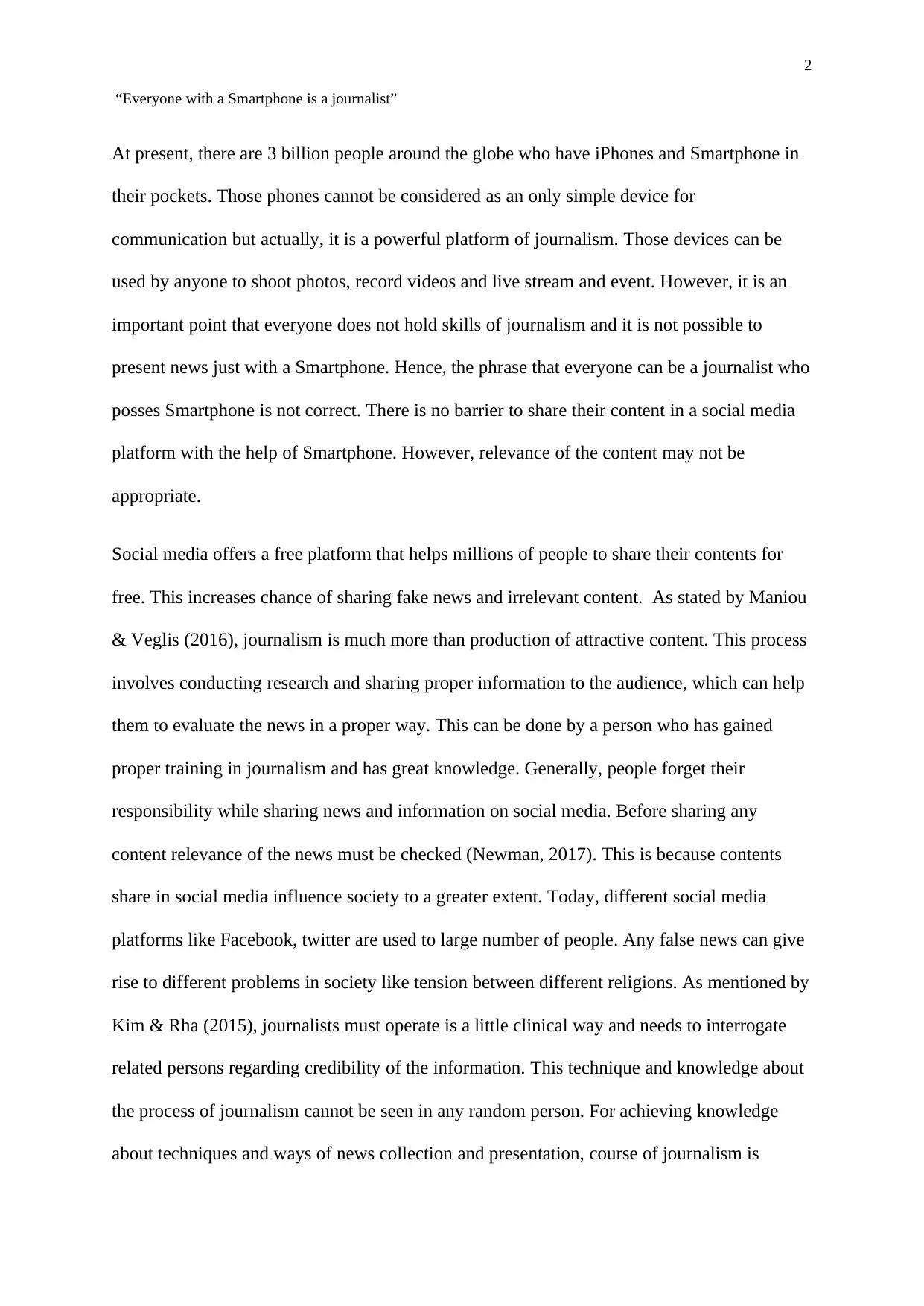
2
“Everyone with a Smartphone is a journalist”
At present, there are 3 billion people around the globe who have iPhones and Smartphone in
their pockets. Those phones cannot be considered as an only simple device for
communication but actually, it is a powerful platform of journalism. Those devices can be
used by anyone to shoot photos, record videos and live stream and event. However, it is an
important point that everyone does not hold skills of journalism and it is not possible to
present news just with a Smartphone. Hence, the phrase that everyone can be a journalist who
posses Smartphone is not correct. There is no barrier to share their content in a social media
platform with the help of Smartphone. However, relevance of the content may not be
appropriate.
Social media offers a free platform that helps millions of people to share their contents for
free. This increases chance of sharing fake news and irrelevant content. As stated by Maniou
& Veglis (2016), journalism is much more than production of attractive content. This process
involves conducting research and sharing proper information to the audience, which can help
them to evaluate the news in a proper way. This can be done by a person who has gained
proper training in journalism and has great knowledge. Generally, people forget their
responsibility while sharing news and information on social media. Before sharing any
content relevance of the news must be checked (Newman, 2017). This is because contents
share in social media influence society to a greater extent. Today, different social media
platforms like Facebook, twitter are used to large number of people. Any false news can give
rise to different problems in society like tension between different religions. As mentioned by
Kim & Rha (2015), journalists must operate is a little clinical way and needs to interrogate
related persons regarding credibility of the information. This technique and knowledge about
the process of journalism cannot be seen in any random person. For achieving knowledge
about techniques and ways of news collection and presentation, course of journalism is
“Everyone with a Smartphone is a journalist”
At present, there are 3 billion people around the globe who have iPhones and Smartphone in
their pockets. Those phones cannot be considered as an only simple device for
communication but actually, it is a powerful platform of journalism. Those devices can be
used by anyone to shoot photos, record videos and live stream and event. However, it is an
important point that everyone does not hold skills of journalism and it is not possible to
present news just with a Smartphone. Hence, the phrase that everyone can be a journalist who
posses Smartphone is not correct. There is no barrier to share their content in a social media
platform with the help of Smartphone. However, relevance of the content may not be
appropriate.
Social media offers a free platform that helps millions of people to share their contents for
free. This increases chance of sharing fake news and irrelevant content. As stated by Maniou
& Veglis (2016), journalism is much more than production of attractive content. This process
involves conducting research and sharing proper information to the audience, which can help
them to evaluate the news in a proper way. This can be done by a person who has gained
proper training in journalism and has great knowledge. Generally, people forget their
responsibility while sharing news and information on social media. Before sharing any
content relevance of the news must be checked (Newman, 2017). This is because contents
share in social media influence society to a greater extent. Today, different social media
platforms like Facebook, twitter are used to large number of people. Any false news can give
rise to different problems in society like tension between different religions. As mentioned by
Kim & Rha (2015), journalists must operate is a little clinical way and needs to interrogate
related persons regarding credibility of the information. This technique and knowledge about
the process of journalism cannot be seen in any random person. For achieving knowledge
about techniques and ways of news collection and presentation, course of journalism is
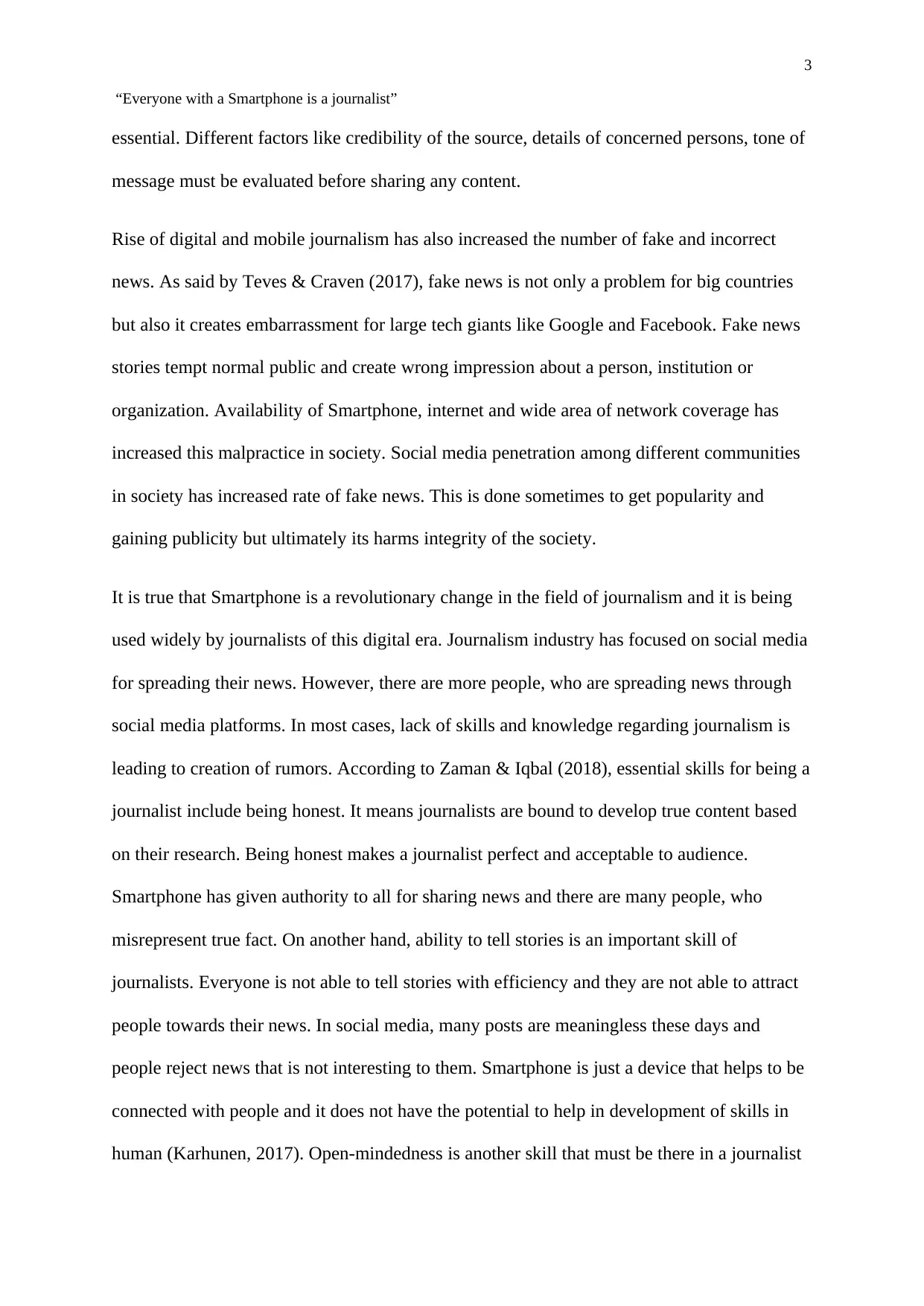
3
“Everyone with a Smartphone is a journalist”
essential. Different factors like credibility of the source, details of concerned persons, tone of
message must be evaluated before sharing any content.
Rise of digital and mobile journalism has also increased the number of fake and incorrect
news. As said by Teves & Craven (2017), fake news is not only a problem for big countries
but also it creates embarrassment for large tech giants like Google and Facebook. Fake news
stories tempt normal public and create wrong impression about a person, institution or
organization. Availability of Smartphone, internet and wide area of network coverage has
increased this malpractice in society. Social media penetration among different communities
in society has increased rate of fake news. This is done sometimes to get popularity and
gaining publicity but ultimately its harms integrity of the society.
It is true that Smartphone is a revolutionary change in the field of journalism and it is being
used widely by journalists of this digital era. Journalism industry has focused on social media
for spreading their news. However, there are more people, who are spreading news through
social media platforms. In most cases, lack of skills and knowledge regarding journalism is
leading to creation of rumors. According to Zaman & Iqbal (2018), essential skills for being a
journalist include being honest. It means journalists are bound to develop true content based
on their research. Being honest makes a journalist perfect and acceptable to audience.
Smartphone has given authority to all for sharing news and there are many people, who
misrepresent true fact. On another hand, ability to tell stories is an important skill of
journalists. Everyone is not able to tell stories with efficiency and they are not able to attract
people towards their news. In social media, many posts are meaningless these days and
people reject news that is not interesting to them. Smartphone is just a device that helps to be
connected with people and it does not have the potential to help in development of skills in
human (Karhunen, 2017). Open-mindedness is another skill that must be there in a journalist
“Everyone with a Smartphone is a journalist”
essential. Different factors like credibility of the source, details of concerned persons, tone of
message must be evaluated before sharing any content.
Rise of digital and mobile journalism has also increased the number of fake and incorrect
news. As said by Teves & Craven (2017), fake news is not only a problem for big countries
but also it creates embarrassment for large tech giants like Google and Facebook. Fake news
stories tempt normal public and create wrong impression about a person, institution or
organization. Availability of Smartphone, internet and wide area of network coverage has
increased this malpractice in society. Social media penetration among different communities
in society has increased rate of fake news. This is done sometimes to get popularity and
gaining publicity but ultimately its harms integrity of the society.
It is true that Smartphone is a revolutionary change in the field of journalism and it is being
used widely by journalists of this digital era. Journalism industry has focused on social media
for spreading their news. However, there are more people, who are spreading news through
social media platforms. In most cases, lack of skills and knowledge regarding journalism is
leading to creation of rumors. According to Zaman & Iqbal (2018), essential skills for being a
journalist include being honest. It means journalists are bound to develop true content based
on their research. Being honest makes a journalist perfect and acceptable to audience.
Smartphone has given authority to all for sharing news and there are many people, who
misrepresent true fact. On another hand, ability to tell stories is an important skill of
journalists. Everyone is not able to tell stories with efficiency and they are not able to attract
people towards their news. In social media, many posts are meaningless these days and
people reject news that is not interesting to them. Smartphone is just a device that helps to be
connected with people and it does not have the potential to help in development of skills in
human (Karhunen, 2017). Open-mindedness is another skill that must be there in a journalist
⊘ This is a preview!⊘
Do you want full access?
Subscribe today to unlock all pages.

Trusted by 1+ million students worldwide
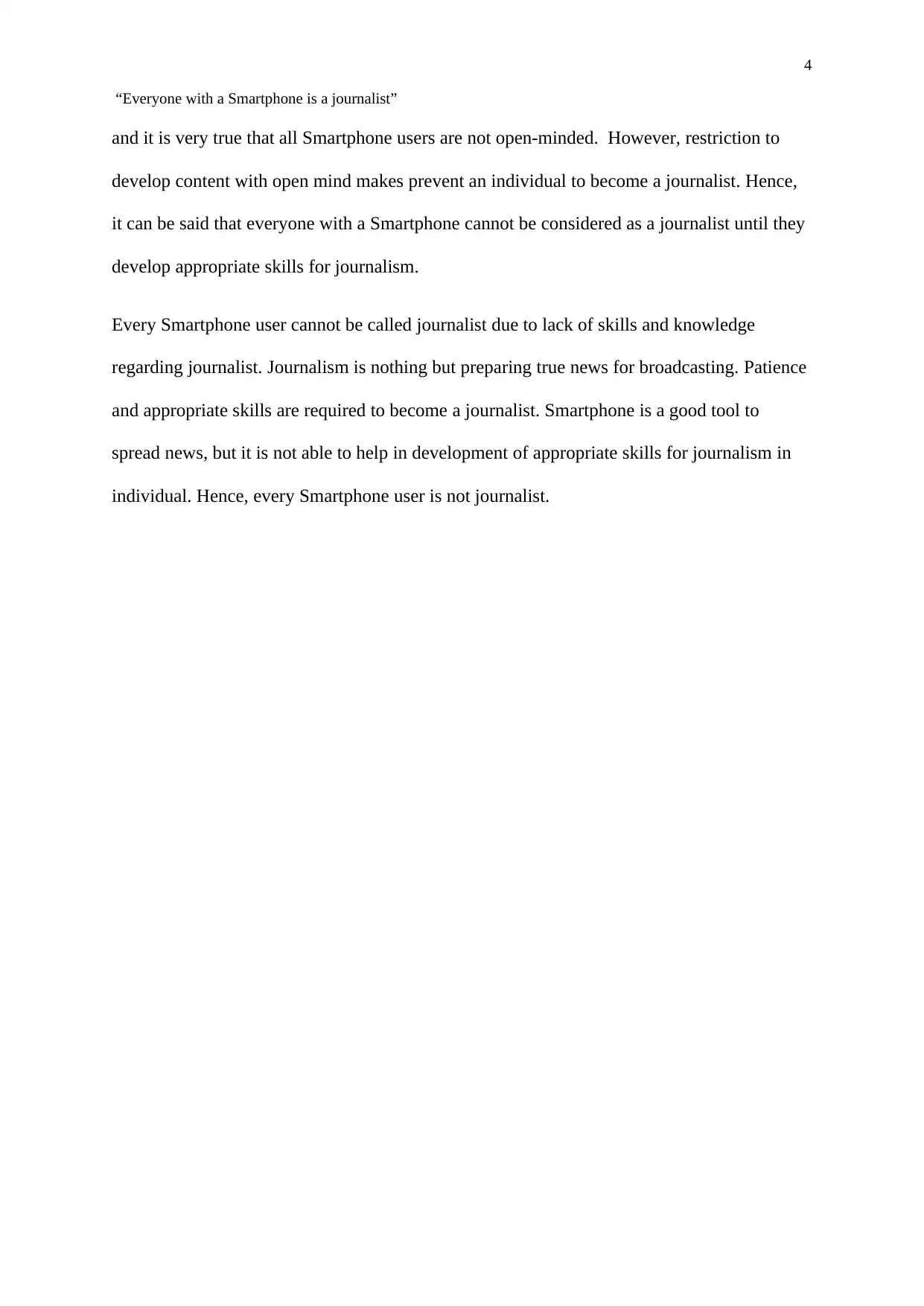
4
“Everyone with a Smartphone is a journalist”
and it is very true that all Smartphone users are not open-minded. However, restriction to
develop content with open mind makes prevent an individual to become a journalist. Hence,
it can be said that everyone with a Smartphone cannot be considered as a journalist until they
develop appropriate skills for journalism.
Every Smartphone user cannot be called journalist due to lack of skills and knowledge
regarding journalist. Journalism is nothing but preparing true news for broadcasting. Patience
and appropriate skills are required to become a journalist. Smartphone is a good tool to
spread news, but it is not able to help in development of appropriate skills for journalism in
individual. Hence, every Smartphone user is not journalist.
“Everyone with a Smartphone is a journalist”
and it is very true that all Smartphone users are not open-minded. However, restriction to
develop content with open mind makes prevent an individual to become a journalist. Hence,
it can be said that everyone with a Smartphone cannot be considered as a journalist until they
develop appropriate skills for journalism.
Every Smartphone user cannot be called journalist due to lack of skills and knowledge
regarding journalist. Journalism is nothing but preparing true news for broadcasting. Patience
and appropriate skills are required to become a journalist. Smartphone is a good tool to
spread news, but it is not able to help in development of appropriate skills for journalism in
individual. Hence, every Smartphone user is not journalist.
Paraphrase This Document
Need a fresh take? Get an instant paraphrase of this document with our AI Paraphraser
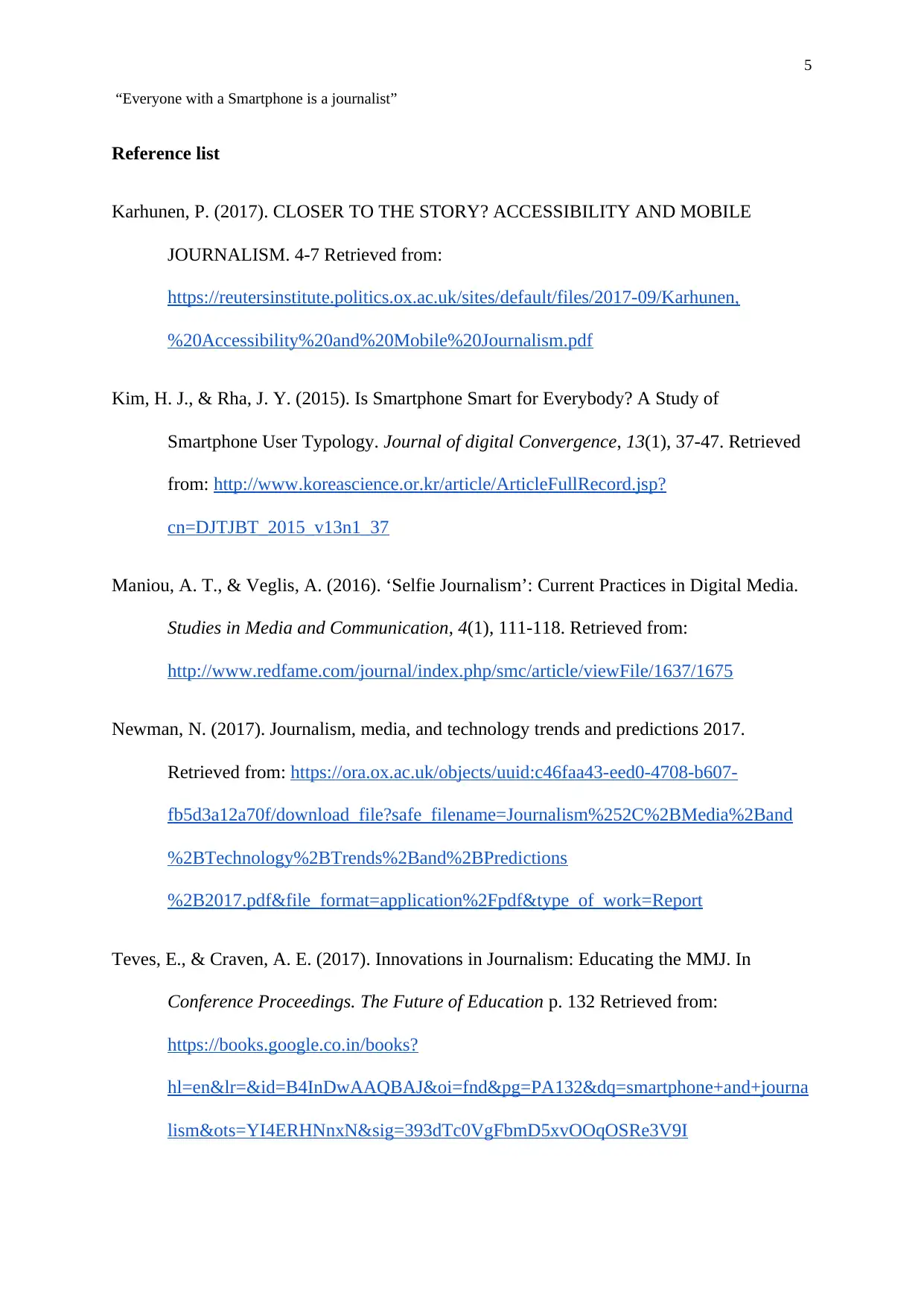
5
“Everyone with a Smartphone is a journalist”
Reference list
Karhunen, P. (2017). CLOSER TO THE STORY? ACCESSIBILITY AND MOBILE
JOURNALISM. 4-7 Retrieved from:
https://reutersinstitute.politics.ox.ac.uk/sites/default/files/2017-09/Karhunen,
%20Accessibility%20and%20Mobile%20Journalism.pdf
Kim, H. J., & Rha, J. Y. (2015). Is Smartphone Smart for Everybody? A Study of
Smartphone User Typology. Journal of digital Convergence, 13(1), 37-47. Retrieved
from: http://www.koreascience.or.kr/article/ArticleFullRecord.jsp?
cn=DJTJBT_2015_v13n1_37
Maniou, A. T., & Veglis, A. (2016). ‘Selfie Journalism’: Current Practices in Digital Media.
Studies in Media and Communication, 4(1), 111-118. Retrieved from:
http://www.redfame.com/journal/index.php/smc/article/viewFile/1637/1675
Newman, N. (2017). Journalism, media, and technology trends and predictions 2017.
Retrieved from: https://ora.ox.ac.uk/objects/uuid:c46faa43-eed0-4708-b607-
fb5d3a12a70f/download_file?safe_filename=Journalism%252C%2BMedia%2Band
%2BTechnology%2BTrends%2Band%2BPredictions
%2B2017.pdf&file_format=application%2Fpdf&type_of_work=Report
Teves, E., & Craven, A. E. (2017). Innovations in Journalism: Educating the MMJ. In
Conference Proceedings. The Future of Education p. 132 Retrieved from:
https://books.google.co.in/books?
hl=en&lr=&id=B4InDwAAQBAJ&oi=fnd&pg=PA132&dq=smartphone+and+journa
lism&ots=YI4ERHNnxN&sig=393dTc0VgFbmD5xvOOqOSRe3V9I
“Everyone with a Smartphone is a journalist”
Reference list
Karhunen, P. (2017). CLOSER TO THE STORY? ACCESSIBILITY AND MOBILE
JOURNALISM. 4-7 Retrieved from:
https://reutersinstitute.politics.ox.ac.uk/sites/default/files/2017-09/Karhunen,
%20Accessibility%20and%20Mobile%20Journalism.pdf
Kim, H. J., & Rha, J. Y. (2015). Is Smartphone Smart for Everybody? A Study of
Smartphone User Typology. Journal of digital Convergence, 13(1), 37-47. Retrieved
from: http://www.koreascience.or.kr/article/ArticleFullRecord.jsp?
cn=DJTJBT_2015_v13n1_37
Maniou, A. T., & Veglis, A. (2016). ‘Selfie Journalism’: Current Practices in Digital Media.
Studies in Media and Communication, 4(1), 111-118. Retrieved from:
http://www.redfame.com/journal/index.php/smc/article/viewFile/1637/1675
Newman, N. (2017). Journalism, media, and technology trends and predictions 2017.
Retrieved from: https://ora.ox.ac.uk/objects/uuid:c46faa43-eed0-4708-b607-
fb5d3a12a70f/download_file?safe_filename=Journalism%252C%2BMedia%2Band
%2BTechnology%2BTrends%2Band%2BPredictions
%2B2017.pdf&file_format=application%2Fpdf&type_of_work=Report
Teves, E., & Craven, A. E. (2017). Innovations in Journalism: Educating the MMJ. In
Conference Proceedings. The Future of Education p. 132 Retrieved from:
https://books.google.co.in/books?
hl=en&lr=&id=B4InDwAAQBAJ&oi=fnd&pg=PA132&dq=smartphone+and+journa
lism&ots=YI4ERHNnxN&sig=393dTc0VgFbmD5xvOOqOSRe3V9I

6
“Everyone with a Smartphone is a journalist”
Zaman, B., & Iqbal, J. (2018). Citizen Journalism: An Inquisitive Analysis of the Usage of
Mobile Applications. PUTAJ-Humanities and Social Sciences, 25(2), 61-70.
Retrieved from: http://putaj.puta.pk/index.php/hss/article/view/604
“Everyone with a Smartphone is a journalist”
Zaman, B., & Iqbal, J. (2018). Citizen Journalism: An Inquisitive Analysis of the Usage of
Mobile Applications. PUTAJ-Humanities and Social Sciences, 25(2), 61-70.
Retrieved from: http://putaj.puta.pk/index.php/hss/article/view/604
⊘ This is a preview!⊘
Do you want full access?
Subscribe today to unlock all pages.

Trusted by 1+ million students worldwide
1 out of 6
Related Documents
Your All-in-One AI-Powered Toolkit for Academic Success.
+13062052269
info@desklib.com
Available 24*7 on WhatsApp / Email
![[object Object]](/_next/static/media/star-bottom.7253800d.svg)
Unlock your academic potential
Copyright © 2020–2025 A2Z Services. All Rights Reserved. Developed and managed by ZUCOL.





